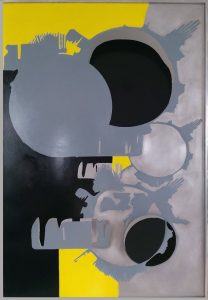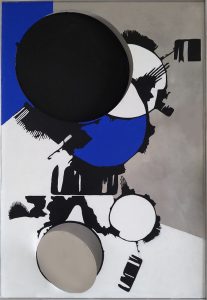정보원_CHUNG Bowon


1) 음향공간 시리즈 S1. 100 x 146 x 10cm 알루미늄 위에 아크릴 2022
<SOUND SPACE S1>, acrylic on aluminum, 100✕146✕10cm each, 2022
2) 음향공간 시리즈 S.2., 알루미늄 위의 아크릴, 100✕146✕10cm, 2022
<Series SOUND SPACE S2>, acrylic on aluminium, 100✕146✕10cm, 2022, *기술자문: 안길재 기술지원: Akshita Nagloor
정보원은 1971년 서울대학교 미술대학과 동 대학원 조소과 석사학위를 마치고 1973년 도불, 파리 국립 장식 미술학교 조각과, 파리 국립 미술학교 건축과를 졸업하였다. 1975년 씨떼 데 자르의 불란서 문화성 소속 작업실, 씨떼 노르벵과 까샹 아뜰리에에서 작업하였다. 1984년에는 프랑스 문화성 국립현대미술재단에서 작품을 소장하였고 1982년 아카데미 드 파리 주최 헤네옹 상의 공동 수상자로 선정되었다. 1987 모브즈 현대미술 비엔날레에 참가, 1985년에는 끄레르몽 훼랑 예술제에서 회화상을 수상했다.
대학과 대학원에서 조각과 건축 공부를 병행하며 건축, 조각의 상관성에 늘 관심을 갖고 작업해 왔다. 파리에서 작가 생활을 하던 중, ‘88 서울 올림픽 조직위원회’에서 주최한 ‘88 올림픽 성화 도착 기념 조형물’ 현상안에 당선되어 1988년 제주도에 조형물을 설치하게 되었다. 1995년 온양 삼성 반도체 공장, 1995년 산업은행 전산센터 조형물을 제작하였고 1996년 대한민국 국회 건립 50주년 기념 조형물 현상안에 당선, 1999년 LG-Art center, 2000년 김해 연지 조각 공원, 2000년 산업은행, 2005년 삼성 전자 30주년 기념 조형작품을 제작하였다. 1987년 한국미술관, 1989년 현대화랑, 1998년 호암갤러리 아트페어, 1990년 키킨다 현대 미술관 등 전시회를 가졌고, 1992년 석주미술상, 1995년 문화체육부 주최 환경 문화상을 수상하였다. 일신 문화재단, 국립 현대 미술관, 경기도 미술관, 일본 센다이 에어포트 골프장, 상하이 대한민국 영사관 등 작품과 조형물이 다수 소장되어 있다.
조각가인 나에게는, 덩어리를 가진 한 구조물을 만들기보다는 서로 다른 개체 간에 생기는 긴장감이 더 중요하다. 구조물과 구조물 사이, 볼륨과 볼륨 사이에 생기는 긴장감, 그 주변을 맴도는 보이지 않는 기류나 음파까지도 내 작업의 영역이다. 나의 평면 작업은 평면 이면에 숨어있는 3차 원공간, 보이지 않는 소리의 영역까지도 옮겨오려는 작업이다. 사회의 모습이나 새로운 테크놀로지의 변화는 끊임없는 나의 호기심이며 이것을 어떻게 내 작업에 녹여낼 수 있을까 항상 생각한다. 또 내가 해 왔던 퍼블릭 공간에 놓인 작품들은, 작품의 공간과 빈 공간 사이를 지나다니며 그 작품을 접하는 사람들, 또 주변 환경까지도 내 작품의 일부이다. 컴퓨터 작업은 내 조각물이나 평면 작업에 기초 작업이 되며 VR 작업은 즉흥적 공간 표현이나 볼륨의 이해를 용이하게 한다. 금속을 주로 다루는 조각가로서 금속재료를 사용하여 3D-입체 작업을 하기도, 또 평면을 뚫어 깊이를 나타나게 하는 2D-평면 작업을 하기도 한다. 알루미늄판에 도형을 파서 그려 넣고, 표면을 거칠게 혹은 매끄럽게 하기도 하며, 면–선, 투명–불투명, 직선–곡선 등으로 대비시키며 평면에서 3차원 세계를 표현한다. 1991년작 ‘네 대의 피아노를 위한 협주곡, ‘칸타타 BWV56’, ‘다 음성의 탈 구조’ 그리고 1999년 LG Art-Center의 ‘음향 공간’ 등의 이름으로 작업하며 구조물과 그 주변의 빈 공간을 채우는 소리나 음파를 상상했다. 이번 작품들은 BTS 음악의 주파수를 시각화하여 얻어낸 자료를 vectorize 하여 데이터들을 추출하였다. 이 데이터를 확장하고 구성하여 가시 공간에 재배치하며 2D와 3D로 작업하였다. 소리는 음색뿐 아니라 각기 다른 모습의 형태가 존재함을 알게 하는 의미 있는 실험이며 작업이다.
After completing her master’s degree in Sculpture at Seoul National University, CHUNG Bowon studied sculpture at the Ecole Nationale Supérieure des Arts Décoratifs, and architecture at the Ecole Nationale supérieure des Beaux-Arts UP6. In 1975, she was assigned to the studio of the French Ministry of Culture of the Cité des Arts, and then worked at Cité Norvin and at the studio of Cachan. In 1984, the FNAC-Fonds National d’Art Contemporain-Ministère de la Culture, purchased the first work and placed it in the collection of the Ministry of Culture. In 1982, she was awarded as a co-winner of Prix Fénéon, the Academie de Paris. She exhibited works at Salon Villeparisis, Salon Montrouge, and participated in Sculpture Biennale ’87 Maubeuge, Musée d’art Moderne in 1987. She also won painting prize at the Festival d’art Contemporain de Clermont Ferrand.
CHUNG explored the connections between the two fields of study – sculpture and architecture. After graduating from school in Paris and working as an artist, in 1987, she was selected in the competition for the ‘88 Olympic Monument to Celebrate the Arrival of the Sacred Flame. The monument was installed in Jeju Island in 1988. She also produced works for the Onyang Samsung Electronics, the Korea Development Bank IT Center in 1995. In 1996, she won the competition for the 50th anniversary commemoration of the National Assembly of the Republic of Korea. Important art projects include: LG-Art Center, Yeonji Sculpture Park in Gimhae, Korea Development Bank, and the Monument commemorating the 30th anniversary of Samsung Electronics.
Art exhibitions at the Hankook Museum of Art in 1987, Hyundai Gallery in 1989, Hoam Gallery Art Fair in 1998, Kikinda Museum of Modern Art in 1990. The collections include: Ilshin Cultural Foundation, National Museum of Contemporary Art, Gyeonggi Museum of Art, and the Korean Consulate in Shanghai.
As a sculptor, the tension that arises while creating a structure between other pieces is more important than just creating one mass of sculpture. I also imagined myself looking at sound waves hovering around my structures, feeling the sound waves revolve around the open and closed spaces. My plane works with moving the hidden, invisible three-dimensional space into two dimensions. In particular, since the work will be placed in a public space means that it is a complex work that requires me to consider the people who come into contact with this work, the surrounding environment, and even their movements.
Changes in society and new technologies are in my constant mind, and I have always thought about how I can melt this into my work. Computer work is the basis for my sculptures or plane work, and VR work facilitates improvisational spatial expression or understanding of volume. As an artist who mainly works with metal, I use metallic materials to reveal depth by piercing planes. Figures are engraved and drawn on an aluminum plate, and the surface is roughened or smoothed, and the three-dimensional world is expressed in a plane by contrasting with face-line, transparency and opacity, straight lines and curves, etc. Working under the name ‘Concerto for Four Pianos, ‘Cantata BWV 56’ ‘The Polyphonic Deconstruction’ in 1991, and ‘Symphonic Space’ at LG Art-Center in 1999, I imagined the sound of filling the structure and the empty space.
The works in this exhibition at the Total Museum visualize the frequencies of BTS music and vectorize the data obtained to extract the data. These materials were extended, reconstructed and worked in plane and three-dimensional. This work is a meaningful experiment and work that show that sound exists not only in the timbre but also in different shapes.